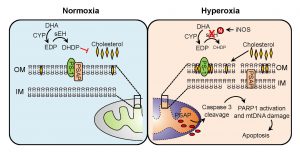November 2019
J Clin Invest. doi: 10.1172/JCI123835
Soluble epoxide hydrolase promotes astrocyte survival in retinopathy of prematurity
Retinopathy of prematurity (ROP) is a complication of treating preterm infants with O2. It is estimated that as many as 10% of very premature infants become blind as a consequence of aberrant retinal neovascularization that leads to fibrovascular retinal detachment. Treatment strategies have focused on vascular ablative therapy and more recently on anti-vascular endothelial growth factor–based approaches. Another potential contributor to the disease is a deficiency of long-chain polyunsaturated fatty acids (PUFAs), particularly docosahexaenoic acid (DHA), which is particularly abundant in the retina. Hu, Bibli et al, show that a defect in DHA metabolism that arises from the tyrosine nitration and inhibition of the soluble epoxide hydrolase (sEH) prevents the generation of a DHA diol (19,20-dihydroxydocosapentaenoic acid or DHDP) that protects against astrocyte apoptosis. Fitting with this ROP was more severe in sEH knockout mice than in their wild-type littermates. Mechanistically, 19,20-DHDP prevented astrocyte loss by targeting the mitochondrial membrane to prevent the hyperoxia-induced dissociation of presenilin-1 (PS-1) and PS-1 associated protein (PSAP) to attenuate PARP1 activation and mitochondrial DNA damage. Therapeutic intravitreal administration of 19,20-DHDP not only suppressed astrocyte loss but also reduced pathological vascular tuft formation in sEH knockout mice. Taken together, the data indicate that sEH activity is required for mitochondrial integrity and retinal astrocyte survival in ROP. Moreover, 19,20-DHDP may be more effective than DHA as a nutritional supplement at preventing retinopathy in preterm infants.